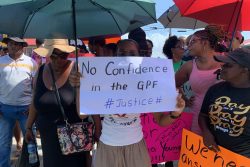(This is the ninth in a 10-part series intended to look at some of the issues surrounding Guyana’s bid for funds from the World Bank-administered Forest Carbon Partnership Fund (FCPF) and from Norway, and for the President’s Low Carbon Development Strategy.)
By Janette Bulkan
In my last article I examined the losses of carbon from mining, agriculture and roads in Guyana’s forests. These losses from forests are the equivalent of emissions from factory exhaust stacks. The losses must be assessed alongside the gains in carbon and the standing stock of carbon in the trees, if Guyana is to participate in carbon trading schemes under the rubric of REDD (Reduced Emissions from Deforestation and Degradation). REDD is one of the approaches being negotiated internationally towards a replacement for the Kyoto Protocol 1997.
In this article I will discuss estimation of carbon emissions due to logging. Logging damage is forest degradation, including biomass and carbon density change, rather than deforestation because the forest biomass can usually recover from logging damage, unless the damage is severe. Estimation of biomass/carbon loss says nothing about degradation due to damage to species biodiversity or forest structure.
The forests of Guyana contain 1000 or more species of woody plants, almost all of them trees. Because of traditional market preferences, a near-absence of conventional marketing of technically adequate timbers, and a Guyana Forestry Commission (GFC) which does not insist that loggers follow best international practices, only around 60 of this 1000 are commercialized and only a half-dozen are really favoured. Consequently, harvesting in the natural forest is highly selective. Some of the most preferred timbers grow in small areas of particular combinations of soil type, topography and water availability. These areas – known as “reefs” – are especially liable to be over-harvested because the GFC does not insist on observance of its own between-tree distance rule: that there should be 10 metres between stumps of felled trees. This distance rule has a sound basis in research by the Tropenbos-Guyana programme in the 1990s.
Hence in the forest where GFC supervision is poor we see intensive and highly damaging harvesting in reefs, and considerable areas where the preferred timbers do not grow and no harvesting has been done, and areas of harvesting of scattered trees. This patchiness greatly complicates estimation of damage from logging and hence of carbon emissions. Here I give a range of estimates.
Area-based estimate of carbon
emissions from logging damage
For this estimate I turn again to the biomass study by Hans ter Steege for Iwokrama in 2001. By reference to the experimental studies of the Tropenbos-Guyana programme at Pibiri near Mabura, he summarized average extraction rates as 1.5-2.5 tonnes of carbon per hectare (tC/ha) but rising to 35-50 tC/ha in reefs. In the reduced impact logging studies by Tropenbos, the conventional (uncontrolled) logging damage was 1.5 times the amount of timber extracted. So here I am using 2 tC/ha extracted x 1.5 damage factor = 3 tC/ha mortally damaged on average. This may be too low, because one figure for Barama is 5.5 tC/ha of mortal damage but there associated with a higher intensity of timber extraction. I multiply this 3 tC/ha by the areas of annual harvests.
Long-term (15-25 years) Timber Sales Agreements (TSAs) covered 4.2 million hectares (Mha) in 2008 (GFC data), thus an annual coupe of 170,000 ha/year for a 25-year licence period. This does not take account of areas inoperable because of being too steep or too swampy because the GFC does not provide such data. What is in the public domain, from the summaries of FSC certification evaluations for Barama, shows great variation between compartments of forest. Barama’s current compartment 4 is considered to be 92 per cent operable, but compartments 1-3 were on average only 33 per cent operable.
This would mean a degradation emission from logging damage in TSAs of 170,000 ha x 3tC/ha = 0.5 million tonnes of carbon (MtC).
Short-term (2-year) State Forest Permissions (SFPs) and SFP conversions areas (intended for conversion at some time to long-term TSAs but GFC has not progressed in the conversion) covered 1.6 Mha in 2008 (GFC data), thus an annual coupe of 823,000 ha/year for a 2-year licence period. Again neglecting operability factors because of non-disclosure by the GFC, I estimate a degradation emission from logging damage in SFPs of 823,000 ha x 3tC/ha = 2.5 MtC.
Volume-based estimate of carbon
emissions from logging damage
Another way of estimating carbon emissions is based on the volumes of logs extracted. As recorded by the GFC for 2008, 275,000 cubic metres (m3) were harvested as logs and 67,000 m3 as chainsawn lumber (the equivalent of 223,000 m3 of logs at 30 per cent conversion from log to lumber), a total harvest of 498,000 m3 of roundwood equivalent volume and thus 249,257 tC in 2008 (2 m3 of biomass = 1 tonne of carbon is a reasonable approximation for the dense timbers of Guyana). This time, I test three estimates of logging damage as ratios to volume of logs extracted:
From ter Steege (2001), 1.5 damaged : 1 extracted, so 249,257 tC x 1.5 = 0.4 MtC.
From a study by Laporte et al. (2007) in the Congo Basin, 8.5 damaged : 3 extracted, so 249,257 tC x 8.5/3 = 0.7 MtC.
From studies by the Edinburgh Centre for Tropical Forestry for Barama in the 1990s, 3 damaged : 1 extracted, so 249,257 tC x 3 = 0.7 MtC.
Clearly there is a great difference between the area-based (3 MtC) and volume-based (0.4 – 0.7 MtC) estimates of logging damage. This may be attributed to loggers harvesting much less than half of the area of their SFPs in each of their 2-year concessions. It is one of the lines of evidence which suggest that the SFP system is being incorrectly operated by the GFC, which is allocating too many SFPs and too large areas per SFP for systematic salvage cutting. According to the 1993 GFC policy on logging concessions the SFPs are intended for small-scale and low-capital operators. Surveys during 1999-2002 showed that the majority of the SFPs were too degraded from years of uncontrolled logging, or from naturally low stocking of good timber trees. These areas should be systematically salvaged and then placed under long-term protection for natural recovery. The GFC’s failure to take appropriate action from these conclusive surveys frustrates the small-scale operators and degrades the forests still further. Here is a clear opportunity for reducing forest carbon emissions.
Carbon emissions from timber extracted
The carbon balance sheet also requires that the extracted timber be accounted, as the longevity of the timber in use cannot be estimated. This is reasonable because the recovery rate in fixed sawmills in Guyana is poor, and at least half of each log is likely to be burned or discarded as waste at the mill. So those emissions are derived as above from the declared volumes harvested, = 0.2 MtC.
Carbon emissions from natural decay
and decomposition in the forest
Again we return to ter Steege’s forest on loam soil in his study for Iwokrama in 2001. 3.5 tC/ha/yr of leaves and twigs and small branches fall, decay and are naturally re-cycled within a year. Standing deadwood and fallen tree boles and large branches (collectively known as coarse woody debris) amount to 7.5 tC/ha and decay over a period of about 20 years. About half of this coarse woody debris decomposes back into carbon dioxide and returned to the atmosphere, while the other half is incorporated into soil organic matter. However, over a period of perhaps 65 years, that organic matter itself decomposes and returns carbon dioxide to the air. As this is a continuous process, and as the International Panel on Climate Change advises against trying to factor soil respiration and soil organic matter dynamics into carbon balance estimates, we can treat that coarse woody debris as emitting 0.4 tC/ha/yr (7.5 tC/ha divided by 20 years). Applying this figure to the 18.5 Mha of forests gives an annual rate of 6.9 MtC.
In my next article I will summarise my estimates for our forest-based above-ground carbon from articles 7, 8 and 9 in this series.








